| 일 | 월 | 화 | 수 | 목 | 금 | 토 |
|---|---|---|---|---|---|---|
| 1 | 2 | 3 | 4 | 5 | ||
| 6 | 7 | 8 | 9 | 10 | 11 | 12 |
| 13 | 14 | 15 | 16 | 17 | 18 | 19 |
| 20 | 21 | 22 | 23 | 24 | 25 | 26 |
| 27 | 28 | 29 | 30 | 31 |
- Political Regime
- the 3rd Law of politics
- Political power
- survival process theory
- the 2nd law
- political phenomena
- Samjae Capacities
- Value Systems
- Cohesion Force
- Order of Choice
- Orderliness of Choice
- Political Change
- Task Delegates of the Ruler: Inner Circle
- mechanism of politics
- new political science
- power and organization
- Political Regimes
- politics and war
- political organization
- politics
- Operation of the 2nd Law
- Mathematical Model of political science
- Mathematical Model of politics
- politics of Inner Circle
- Differences in Individual Abilities and Tendencies
- Regime Change
- Samjae Capacity
- Canonical Politics
- Power
- 1st Law of politics
- Today
- Total
New Political Science
b. Wealth Gap 본문
b. Wealth Gap

Historically, in every political regime, classes have been divided both formally and informally, and in practice, wealth gaps naturally arise in all societies. As one would expect, they still exist today.
In ancient societies, most had a system of slavery. In the Joseon Dynasty, there was a noble class called "yangban" separated from commoners, and there were also the lowest class, the "cheonmin." The Soviet society, which pursued Marxist communism, officially claimed that the issue of social class had been resolved, but the reality was different. At least three distinct classes existed in the Soviet Union. The first class, the elite class, consisted of high-ranking government officials, party leaders, high-ranking military officers, industrial managers, scientists, artists, and writers, numbering around a million households. They enjoyed benefits such as owning single-family homes, additional allowances for their own and family travel or vacations, and owning villas or cars. A very few even enjoyed the privilege of traveling to the West. The second class formed the middle class of Soviet society, consisting of mid-level civil and military bureaucrats, collective farm managers, and moderately wealthy skilled workers and industrial technicians, numbering around four to five million households. The third class consisted of the vast majority of the population, namely workers and peasant masses, with over 50 million households. Today, in capitalist societies, the wealth gap leads to a substantial class differentiation.
The causal origin of such inequality is the survival struggle [Tab.1.1]㉠. In any struggle, there are always winners and losers, with the winners acquiring more and the losers getting less. Consequently, inequality inevitably follows the battle for survival. The history of imperialist invasions centered around Europe led to the colonial era, in which the entire world became subjugated to the Christian cultural sphere. Within this macro-level inequality structure, on one side, industrialized Europe was positioned, while on the other side, regions deprived of their rights were situated. Thus, the source of class differentiation and wealth disparity within nations and global inequality is the same.
'Mechanism of Politics' 카테고리의 다른 글
| (3) Phenomenology of Political Ideology (0) | 2023.12.18 |
|---|---|
| b. ㉣ Primitive Economy and Advanced Economy (0) | 2023.12.18 |
| Chapter 4. A. (1) Conditions for the Birth & Death of P. Organizations (0) | 2023.12.14 |
| b. ㉠ Efficiency of Cooperative Relationships (0) | 2023.12.14 |
| b. Concentration of Power and its Cause (0) | 2023.12.14 |


